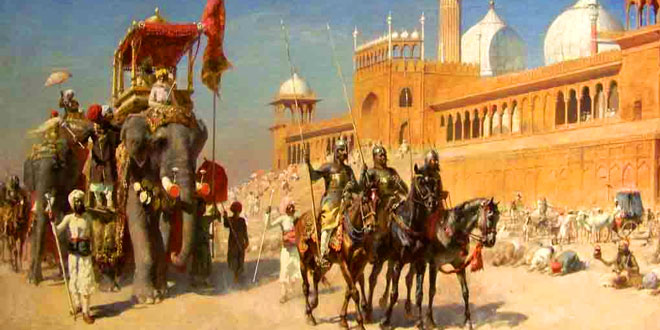Question: Who were the peshwas? How did they strengthen Maratha power? or How did they come to power?
Answer: The term Peshwa means Chief minister. After Shivaji’s death, the Peshwas become powerful and controlled the Maratha empire from 1713 to 1761. Balaji Vishwanath captured territories from the Mughals. He also got the right to collect taxes from six provinces in the Deccan. Baji Rao I conquered Malwa, Southern Gujarat and parts of Bundelkhand. He also defeated the Nizam of Hyderabad. Balaji Baji Rao forced the kingdom of Mysore and Hyderabad to hand over territories and pay an annual tribute.
Question: How and when did the Maratha Kingdom come to an end?
Answer: The Mughal emperor entered into a treaty with the Marathas by which the Marathas agreed to defend Mughals from further invasions of Ahmad Shah Abdali. In return they gave Marathas right to collect to collect Chauth and sardeshmukhi from Punjab and Sind. This brought the Marathas great wealth. But it also earned them the anger of the Sikhs, the Rajputs and the kingdoms of Bengal and Hyderabad.
The 1761 CE Marathas clashed with Abdali in the Battle of Panipat, neither Sikhs nor Rajputs helped Marathas. The Marathas were routed, they never recovered fully from this defeat. As the powers of Peshwas declined, the various Marathas chiefs established their separate states.
Question: Write a short note on the rebellion of the Jats?
Answer: Under the leadership of Gokula, Jat peasants rose in rebellion against high taxes levied by the Mughals. In 1619 CE, they built forts and blocked caravan routes from Agra to Delhi. They killed the faujdars who carried out the oppressive policies of Aurangzeb. One of their kings, Surajmal, established the kingdom of Bharatpur. However, they could not succeed against the might of the Mughals. Gokula was executed. But the Jats continued to trouble the Mughals for years. In 1691 CE, the rebels reappeared in great force and captured Akbar’s tomb.
Question: Write a short note on the Satnamis.
Answer: In 1672 CE, the Satnamis, a Hindu sect from the same region as the Jats, rebelled against the oppressive policies of the Mughals. The Satnamis were mostly goldsmiths, tanners and sweepers, who aimed at overthrowing Aurangzeb and establishing a just rule. Their revolt was put down repeatedly by the Mughals. In 1704 CE, the Satnamis revolted for the last time under their leader, Chauraman. But they were defeated by the Mughals, with a heavy loss of lives on their side. Since they shaved their heads they were also called the mundiyas (bald headed).
Question: What were the reasons for the decline of the Mughals?
Answer: The reasons for the decline of the Mughals:
- Aurangzeb’s policies made enemies of the Rajputs, Jats, Sikhs and Marathas.
- Aurangzeb’s frequent wars depleted the treasury, and so the empire was unable to pay the troops on time.
- The troops were fighting on too many fronts at the same time. They were hence unable to prevent the emergence of the challenge of foreign invasions.
- There was a steep fall in revenues from semi-independent provinces and from provinces still under the control of the empire. For example, Golconda, which was a rich state, stopped sending its annual tribute to the Mughals.
- The later Mughal emperors continued to live in the world of fading splendour, out of touch with reality. They were mostly controlled by powerful nobles and were unable to hold the empire together.
- The Mughal Dynasty did not have clear rules of succession. This led to bloody conflicts after the death of every ruler.
Question: Give a short summary of the history of the kingdom of Hyderabad.
Answer: Qamaruddin Chin Qilich Khan, the leader of the Turani group of nobles established the kingdom of Hyderabad in 1724 CE and ruled it in a semi-independent manner. He never openly declared his independence from the Mughal emperor. Qilich Khan was given the titles of Nizam ul Mulk and Asaf Jah. He and his successors were known as the nizams of Asaf Jahi Dynasty.
As the Nizam of Hyderabad, Qilich Khan had to deal with frequent raids of the Marathas. He tried to maintain friendly relationship with both Mughals and Marathas. Qilich Khan also helped the emperor fight against Nadir Shah. He was a capable ruler and hyderabad prospered under him. Hyderabad became well known for its art, culture and cuisine(food). The Asaf Jahis continued to rule the state till it finally merged with Indian Union in 1948 CE.
 Class Notes NCERT Solutions for CBSE Students
Class Notes NCERT Solutions for CBSE Students



